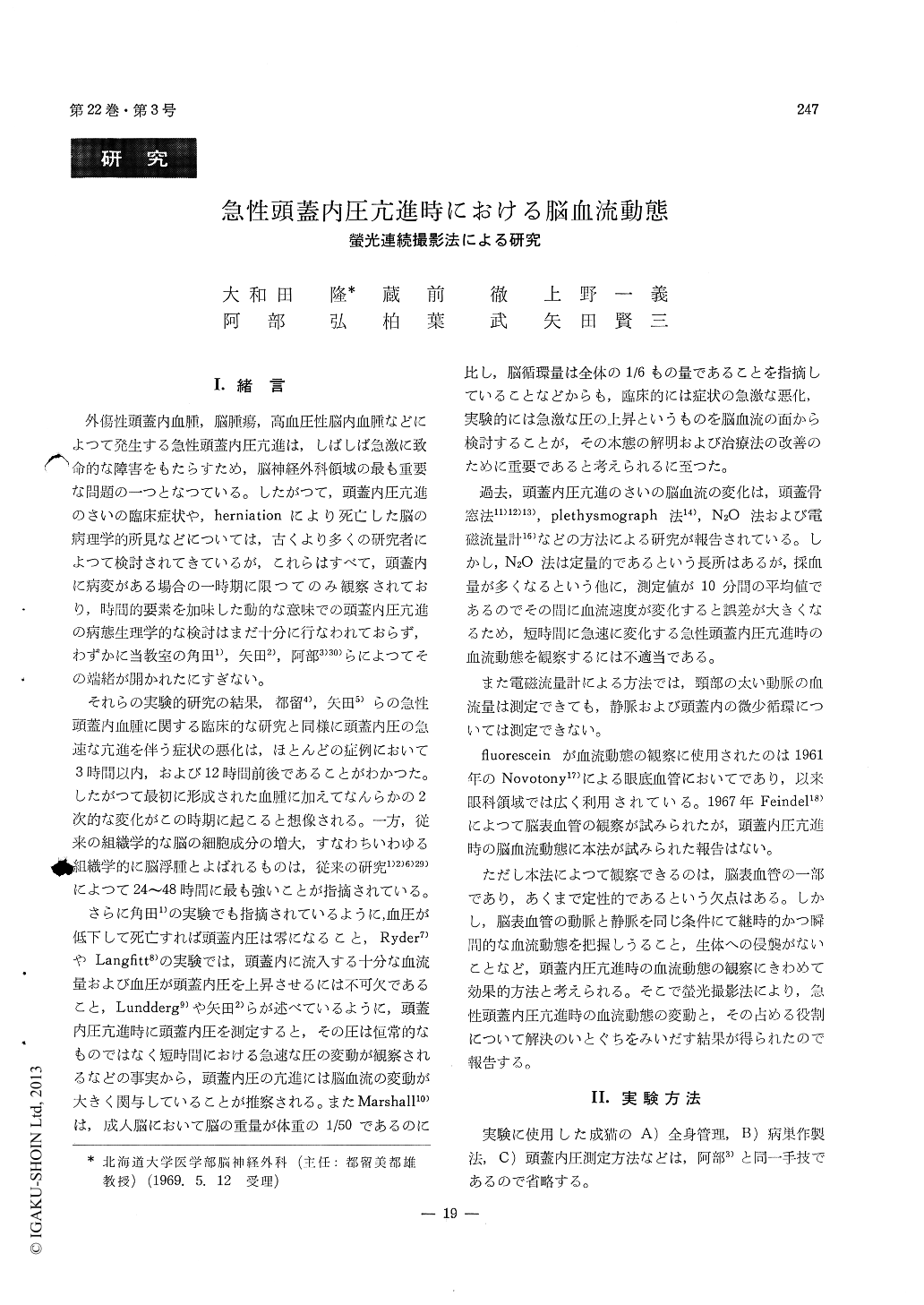Japanese
English
- 有料閲覧
- Abstract 文献概要
- 1ページ目 Look Inside
I.緒言
外傷性頭蓋内血腫,脳腫瘍,高血圧性脳内血腫などによって発生する急性頭蓋内圧亢進は,しばしば急激に致命的な障害をもたらすため,脳神経外科領域の最も重要な問題の一つとなつている。したがって,頭蓋内圧亢進のさいの臨床症状や,herniationにより死亡した脳の病理学的所見などについては,古くより多くの研究者によつて検討されてきているが,これらはすべて,頭蓋内に病変がある場合の一時期に限ってのみ観察されており,時間的要素を加味した動的な意味での頭蓋内圧亢進の病態生理学的な検討はまだ十分に行なわれておらず,わずかに当教室の角田1),矢田2),阿部3)30)らによつてその端緒が開かれたにすぎない。
それらの実験的研究の結果,都留4),矢田5)らの急性頭蓋内血腫に関する臨床的な研究と同様に頭蓋内圧の急速な亢進を伴う症状の悪化は,ほとんどの症例において3時間以内,および12時間前後であることがわかった。したがつて最初に形成された血腫に加えてなんらかの2次的な変化がこの時期に起こると想像される。一方,従来の組織学的な脳の細胞成分の増大,すなわちいわゆる組織学的に脳浮腫とよばれるものは,従来の研究1)2)6)29)によって24〜48時間に最も強いことが指摘されている。
Our previous investigations of the pathophysio-logy of intracranial hypertension have indicated that various secondary pathophysiological changes do not always parallel to the degree of the pressure elevation but are influenced both by degree and duration of the increased intracranial pressure. Also, we have pointed out that the secondary circulatory change due to increased intracranial pressure plays an important role in further elevation of intracranial pressure. The present experimental study was made in an attempt to clarify the circulatory changes under increased intracranial pressure with special regard to time consequence. Also, it was our in-tension to find out which part of the cerebral cir-culatory system is most influenced by the intracranial hypertension.
The experiment was carried out on 22 adult mon-grel cats. While measuring intracranial pressure continuously, an extradurally placed rubber balloon was inflated to elevate intracranial pressure. The pressure was elevated to various levels between 300- 2,000 mmH2O and the same pressure was maintained for various length of time between 30 minutes to 12 hours. Rapid serial photographs of the cortical vessels were taken through a glass window tightly placed over the parietal area following to injection of sodium fluorescein 5mg/kg. B. W. into inferior vena cava. The series of photographs were taken right before and right after the elevation of the intracra-nial pressure, and were repeated every 3 hours thereafter. Before the pressure was elevated the dye appears in cortical arteries of approximately 100-300μ in diameter within 8 seconds after injection of the dye. Within 4 seconds, the dye flows into arterioles and it advances to venule before it disap-pears from the arterioles. The dye disappears from veins of approximately 100-300μ in diameter within 5 seconds following its appearance in the veins. Unless the pressure was elevated to extremely high level (900-2,000mmH2O), the dye appears in the cortical arteries without delay. However, when the pressure reaches to the high level, it delays markedly or sometimes does not appear at all. When the mo-derate degree of pressure (400-700mmH2O) is ma-intained longer than 6 hours, the dye appears in the venule after it completely disappears from the arterioles. Disappearance of the dye from the veins of above mentioned size is delayed whether the pres-sure is markedly elevated or after the moderate pressure is maintained certain period of time. No circulatory change is seen when the pressure is be-low 400 mmH2O. We feel it is important to note that inflow into the cerebral arterial system is not influenced by moderately increased intracranial pres-sure but it mainly dependent to the pressure dif-ference between the intracranial pressure and sys-temic blood pressure. We also like to stress that the circulatory disturbance does not become pro-minent right after the the pressure is elevated but it progressively become prominent as the same pres-sure is maintained, and this circulatory change seems to occur mainly either at capillary level or on the venous side of the cerebral circulation.
Thus, the retardation of intracranial blood flow causes increase in cerebral blood volume and as the result, the intracranial pressure is further elevated.

Copyright © 1970, Igaku-Shoin Ltd. All rights reserved.


